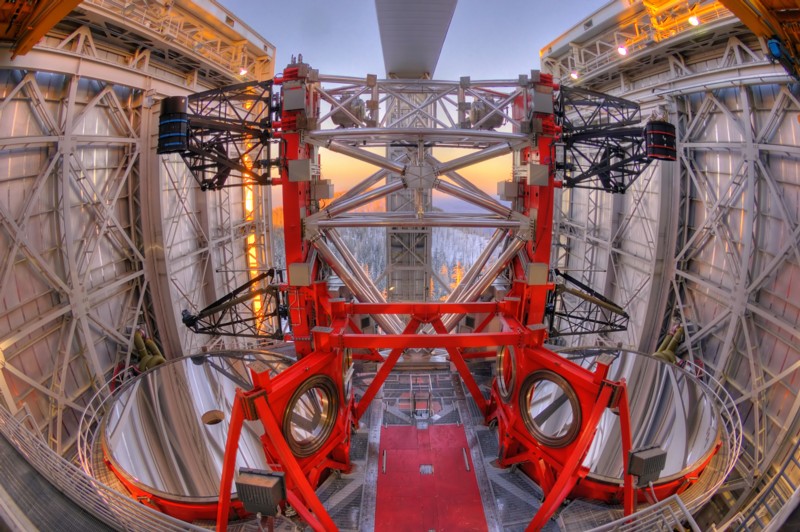After eight and a half years in the making, the Large Binocular Telescope (LBT) is finally ready to begin operation. Yesterday, it unveiled its first image (shown above), the target of which was Beta Pictoris.
The LBT gains its name from its twin 8.4 meter mirrors. While such large mirrors are impressive in their own right, the ability to use them in tandem is what gives the telescope its true power. By placing two mirrors far apart and combining the images, it allows astronomers to improve the resolution as if the mirror was effectively the width of the distance between the mirrors. According to Tom McMahon of the University of Arizona, Tucson and the project manager for the telescope, “Together, the two mirrors form the largest single-mount telescope in the world.”
Although this technique can improve resolution, the total light gathering power is still the same as the mirrors together. Additionally, to pull off this combining of images, known as interferometry, astronomers must carefully process the light from each mirror. The device in charge of collecting and making sense of the data is the Large Binocular Telescope Interferometer (LBTI). Its construction was begun in 2002 and is designed to “explore the regions surrounding nearby star systems for dust and planets”. To achieve this, the LBTI is intended to study the infrared portion of the spectrum in which dust and planets would glow the most strongly.
While the LBT has unprecedented resolving power, it is still not capable of finding Earth sized planet. According to the project’s website, the smallest planets the telescope can expect to discover are around two times the mass of Jupiter. Smaller ones would likely not emit strongly enough and be lost in the glare from their parent star.
On larger scales, the LBTI will be suited for studying of star formation in the Milky Way as well as other, nearby galaxies. Further out, the instrument can be employed to study Ultra Luminous Infrared Galaxies (ULRIGs) and Active Galactic Nuclei (AGN).
With this first image, the team responsible for the telescope and instrument are excited. But already, the LBT is slated for upgrades to the adaptive optics systems which will take much of the next year to install and test. Still, the telescope will be usable for some science during this time. As McMahon stated, “It’s taken time to make sure it works as envisioned, but now it’s time to do science.”


Been a long time coming! Congratulations on this important milestone..
A useful link: http://lbti.as.arizona.edu/LBTI-Main/Project.html
While this may be first light for LBTI, observations using just a single mirror date back to ~2007 (I’ve read several papers on strong lensing in galaxy clusters using data from the LBT). The LBT gallery has an impressive number of images of everything from lensing galaxy clusters and comets to the Horsehead Nebula: http://lbtwww.arcetri.astro.it/astronomical_images.htm
But I’m glad to see the much anticipated LBTI is now online.
Bout time!
Well done LBGT. Oops – I mean LBT.
Good! But the pessimistic side of me would have held out for Earth-analog resolving power.. Humbug!
Yeah, it is too small. (O.o)
Seriously though, it is always good to see new techniques come to fruition.
I’m surprised it was not built on some very high desert mountain. Isn’t that some kind of waste?
Adaptive optics + interferometry, that must be something of a challenge.
The LBT is located in a dark location at Mt. Graham, Arizona and is at 10,400 feet. Not too shabby! 10,400 feet is above 90% of the water vapor in the atmosphere and most of the monsoonal late summer weather. Another plus, Mt. Graham is located away from the lights of Tucson and Phoenix with mountain ranges between. I’ve never been there, but will if I’m ever in that area!
http://maps.google.com/maps?hl=en&q=flagstaff+arizona&um=1&ie=UTF-8&hq=&hnear=Flagstaff,+AZ&gl=us&ei=y8r_TKRxh66wA5_7mLAL&sa=X&oi=geocode_result&ct=image&resnum=1&ved=0CCkQ8gEwAA
Oops.. thought I’d copied the Mt. Graham location??